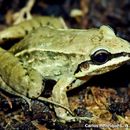Brief Summary
provided by IABIN
Diagnosis A medium size species (males 47.4 ± 3.4 mm snout vent length, females 49.1 ± 3.0 mm snout vent length) of Leptodactylus with sole of foot smooth and barred tibial pattern.
- author
- Esteban O. Lavilla
- editor
- Diego Arrieta
Distribution
provided by IABIN
Known from São Paulo to Santa Catarina State, Brazil.
- author
- Esteban O. Lavilla
- editor
- Diego Arrieta
Diagnostic Description
provided by IABIN
Description of holotype Snout rounded-subelliptical from above, rounded in profile; canthus rostralis indistinct; loreal slightly concave; tympanum distinct, greatest diameter about % eye diameter; vomerine teeth in slightly arched series posterior to choanae; finger lengths in order of decreasing size I = III > II = IV, I > > II; inner metacarpal tubercle oval, smaller than rounded outer metacarpal tubercle; dorsum smooth above anteriorly, warty on sides and posteriorly; 1 pair of distinct dorsolateral folds from eye to groin, 1 pair of indistinct lateral folds; ventral texture smooth; belly disk fold distinct; toe tips not expanded; toes free, lacking fringe or web; subarticular tubercles moderately developed; outer metatarsal tubercle small, round, about 1/4 oval inner metatarsal tubercle; tarsal fold indistinct; no metatarsal fold; posterior surface of tarsus smooth; sole of foot with 1 or 2 indistinct white tubercles. Dorsum brown with faint darker markings including an interorbital blotch and dorsal chevron; dorsolateral folds light outlined posteriorly; upper lip edge dark, bordered above by distinct light stripe from tip of snout passing under eye to angle of jaw; dark canthal stripe above light lip stripe from tip of snout to eye; venter immaculate; posterior surface of thigh mottled above, dark below with distinct light longitudinal stripe. Measurement: snout vent lenght 56.1, head length 20.6, head width 18.4, interorbital distance 3.7, eye-nostril distance 5.0, femur 27.0, tibia 31.5, foot 31.8 . Larval morphology Tadpole with an elliptical and elongated body, which is about 36% of the total length. The maximum body width is located half way in the body. Dorsally, a slight constriction is visible in the posterior half of the body. In dorsal and lateral views the snout is rounded. The eyes are of medium size and laterally directed; eyes are positioned dorsolaterally on the body and visible in dorsal and lateral view. The external nares are located half way between the eyes and the tip of the snout. Narial openings are small, rounded, and laterodorsally positioned. The lateral line system is distinctly visible. Tail fins are low; dorsal and ventral fins are about equal in height and nearly parallel to the tail musculature. The dorsal fin originates slightly anterior to the tail-body junction and the ventral fin originates at the posterior ventral terminus of the body. Maximum tail height about equal to body height. Tail fins slope to a broadly rounded tail tip. Main tail axis eutiurial. Myotomes of tail musculature defined and extending to the posterior tip of the tail. The spiracle is sinistral, relatively short, and directed dorsolaterally, with a rounded and midlateral opening. The vent tube and vent tubeÂ?s apertures are medial relatively to the ventral fin. The oral disc is positioned anteroventrally; it corresponds to about 36.4% of the body width and is not emarginate. The posterior labium of the oral disc has a single row of large and conical marginal papillae with blunt tips, a large rostral gap occupies most of the upper labium (about 65% of the width of the oral disk); no mental gap is present. No submarginal or intramarginal papillae were found. The labial tooth row formula is 2(2)/(3), all labial tooth rows are sub-equal in length; tooth row A-2 is interrupted by a distinct; labial teeth are serrated. Upper and lower jaw sheaths are wide, pigmented for about 1/3 of their width, and their edge is serrated. Measurements (in mm): body length 8.0 , tail muscle height 1.5 , fin height 4.3 , total length 22.3 , eye diameter 0.8 , interorbital distance 1.5 , body maximum width 5.5 , body width at eyes 4.6 , body width at nostrils 2.6 , body maximum height 3.9 , rostro-spiracular distance 5.0 , frontonasal distance 1.0 , naso-ocular distance 0.9 , nostril diameter 0.2 , internarial distance 1.2 , width of oral disc 2.0 , width of dorsolabial gap 1.3 , body length/total length 36% , eye diameter/body length 10% , with of dorsolabial gap/body length 16.25%. Coloration of fixed specimens: Specimens in 10% formalin are overall light brown, with intestinal coils visible through the ventrolateral skin of the body. The dorsal and dorsolateral surfaces of the body are homogeneously brown, grading continuously to a light brown and almost translucent ventral surface. The myotomes of the caudal musculature are well marked. The tail fins and tail musculature are finely speckled with dark melanophores; melanophores are more abundant throughout the dorsal fin and on the posterior half of the ventral fin.
- author
- Esteban O. Lavilla
- editor
- Diego Arrieta
Leptodactylus notoaktites: Brief Summary
provided by wikipedia EN
Leptodactylus notoaktites is a species of frog in the family Leptodactylidae. It is endemic to southeastern Brazil and is known from the states of Santa Catarina, Paraná, and São Paulo state. Common name Iporanga white-lipped frog has been coined for it.
- license
- cc-by-sa-3.0
- copyright
- Wikipedia authors and editors

